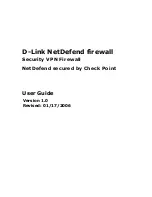
Creating a Drop All Rule
Traffic that does not match any rule in the IP rule set is, by default, dropped by NetDefendOS. For
logging purposes it is nevertheless recommended that an explicit IP rule with an action of Drop for
all source/destination networks/interfaces, and with logging enabled, is placed as the last rule in the
IP rule set. This is often referred to as a drop all rule.
Tip: Include the rule set name in the drop all name
There may be several IP rule sets in use. It is recommended to include the IP rule set
name in the name of the drop all rule so it can be easily identified in log messages.
For example, the drop all rule for the main rule set should be called main_drop_all or
similar.
Traffic Flow Needs an IP Rule and a Route
As stated above, when NetDefendOS is started for the first time, the default IP rules drop all traffic
so at least one IP rule must be added to allow traffic to flow. In fact, two NetDefendOS components
need to be present:
•
A route must exist in a NetDefendOS routing table which specifies on which interface packets
should leave in order to reach their destination.
A second route must also exist that indicates the source of the traffic is found on the interface
where the packets enter.
•
An IP rule in a NetDefendOS IP rule set which specifies the security policy that allows the
packets from the source interface and network bound for the destination network to leave the
NetDefend Firewall on the interface decided by the route.
If the IP rule used is an Allow rule then this is bi-directional by default.
The ordering of these steps is important. The route lookup occurs first to determine the exiting
interface and then NetDefendOS looks for an IP rule that allows the traffic to leave on that interface.
If a rule does not exist then the traffic is dropped.
Figure 3.3. Simplified NetDefendOS Traffic Flow
3.5.1. Security Policies
Chapter 3. Fundamentals
123
Содержание DFL-1600 - Security Appliance
Страница 27: ...1 3 NetDefendOS State Engine Packet Flow Chapter 1 NetDefendOS Overview 27 ...
Страница 79: ...2 7 3 Restore to Factory Defaults Chapter 2 Management and Maintenance 79 ...
Страница 146: ...3 9 DNS Chapter 3 Fundamentals 146 ...
Страница 227: ...4 7 5 Advanced Settings for Transparent Mode Chapter 4 Routing 227 ...
Страница 241: ...5 4 IP Pools Chapter 5 DHCP Services 241 ...
Страница 339: ...6 7 Blacklisting Hosts and Networks Chapter 6 Security Mechanisms 339 ...
Страница 360: ...7 4 7 SAT and FwdFast Rules Chapter 7 Address Translation 360 ...
Страница 382: ...8 3 Customizing HTML Pages Chapter 8 User Authentication 382 ...
Страница 386: ... The TLS ALG 9 1 5 The TLS Alternative for VPN Chapter 9 VPN 386 ...
Страница 439: ...Figure 9 3 PPTP Client Usage 9 5 4 PPTP L2TP Clients Chapter 9 VPN 439 ...
Страница 450: ...9 7 6 Specific Symptoms Chapter 9 VPN 450 ...
Страница 488: ...10 4 6 Setting Up SLB_SAT Rules Chapter 10 Traffic Management 488 ...
Страница 503: ...11 6 HA Advanced Settings Chapter 11 High Availability 503 ...
Страница 510: ...12 3 5 Limitations Chapter 12 ZoneDefense 510 ...
Страница 533: ...13 9 Miscellaneous Settings Chapter 13 Advanced Settings 533 ...
















































